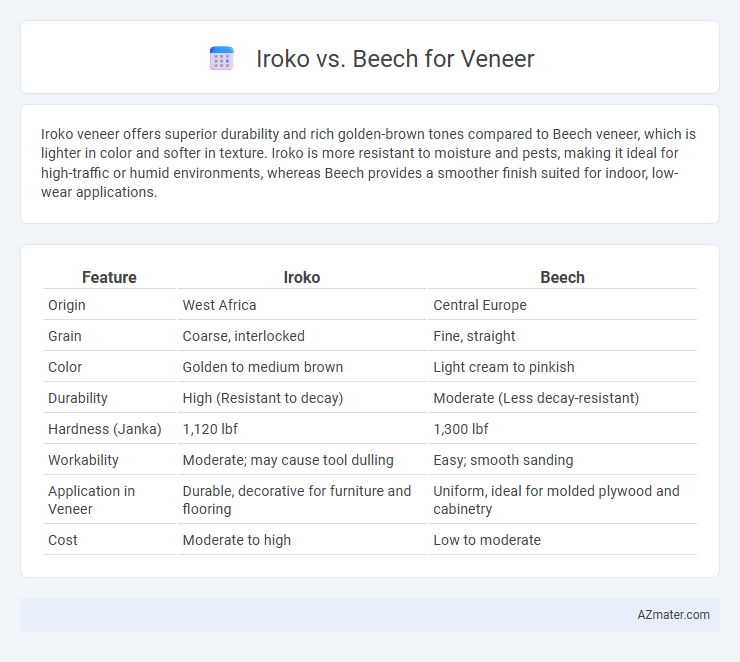Iroko veneer offers superior durability and rich golden-brown tones compared to Beech veneer, which is lighter in color and softer in texture. Iroko is more resistant to moisture and pests, making it ideal for high-traffic or humid environments, whereas Beech provides a smoother finish suited for indoor, low-wear applications.
Table of Comparison
| Feature | Iroko | Beech |
|---|---|---|
| Origin | West Africa | Central Europe |
| Grain | Coarse, interlocked | Fine, straight |
| Color | Golden to medium brown | Light cream to pinkish |
| Durability | High (Resistant to decay) | Moderate (Less decay-resistant) |
| Hardness (Janka) | 1,120 lbf | 1,300 lbf |
| Workability | Moderate; may cause tool dulling | Easy; smooth sanding |
| Application in Veneer | Durable, decorative for furniture and flooring | Uniform, ideal for molded plywood and cabinetry |
| Cost | Moderate to high | Low to moderate |
Introduction to Iroko and Beech Veneer
Iroko veneer, derived from the durable Iroko tree native to West Africa, is prized for its rich golden to medium brown color with bronze undertones and straight grain pattern, offering exceptional resistance to moisture and decay. Beech veneer, sourced from the European Beech tree, features a pale cream to reddish-brown hue with a fine, even texture and straight grain, making it versatile for a range of interior applications. Both veneers provide unique aesthetic qualities and functional benefits, with Iroko excelling in toughness and Beech favored for its smooth finish and uniform appearance.
Botanical Origins and Wood Characteristics
Iroko (Milicia excelsa) is a hardwood native to tropical Africa, known for its coarse texture, interlocked grain, and natural resistance to decay and insects, making it highly durable for veneer applications. Beech (Fagus sylvatica), originating from European temperate forests, features a fine, even texture with a straight grain and a pale cream color that darkens slightly with age, providing a smooth and consistent veneer surface. Both species offer unique aesthetic and functional properties, with Iroko's robustness suited for heavy-use furnishings and Beech prized for its uniformity and ease of finishing.
Color and Grain Comparison
Iroko veneer displays a rich golden to medium brown color with occasional greenish hues, while Beech veneer is lighter, featuring a pale cream to pinkish-brown shade. The grain of Iroko is interlocked and coarse, producing a distinctive textured appearance, whereas Beech has a fine, straight, and uniform grain that provides a smooth and consistent surface. These characteristics make Iroko suitable for bold, warm aesthetics, and Beech ideal for clean, modern designs.
Durability and Hardness Differences
Iroko veneer exhibits higher durability compared to beech, making it more resistant to outdoor elements and wear over time. The hardness of iroko registers around 1,210 on the Janka scale, significantly surpassing beech's rating of approximately 1,300, indicating that iroko is slightly softer but still offers excellent strength and resistance to denting. This makes iroko veneer suitable for applications requiring toughness and longevity, while beech veneer excels in settings where uniform texture and ease of finishing are prioritized.
Workability and Machinability
Iroko veneer offers excellent workability with moderate hardness, making it suitable for intricate carving and shaping, while maintaining good durability. Beech veneer is highly prized for its superior machinability, allowing for smooth cutting, sanding, and finishing due to its uniform, fine grain structure. Both veneers respond well to adhesives and finishes, but Beech generally provides a more consistent surface for precision woodworking applications.
Environmental Sustainability and Sourcing
Iroko veneer offers a sustainable option due to its rapid growth and responsible harvesting practices, minimizing deforestation impact compared to Beech veneer, which often comes from plantations that can lead to monoculture concerns. Iroko's durability reduces the need for frequent replacement, supporting long-term resource conservation, whereas Beech's sourcing in some regions may involve less rigorous sustainability standards. Certifications like FSC are more commonly available for Iroko, ensuring traceable and ethical sourcing critical for environmentally conscious projects.
Cost and Market Availability
Iroko veneer generally commands a higher price than Beech due to its durability and exotic appeal, making it a premium choice for high-end woodworking projects. Beech veneer, widely available and more affordable, offers excellent workability but lacks the natural oils and moisture resistance found in Iroko. Market availability favors Beech in European and North American regions, while Iroko is predominantly sourced from West African markets, impacting lead times and cost fluctuations.
Common Applications in Veneering
Iroko veneer is widely used in high-traffic furniture, cabinetry, and paneling due to its durability and rich golden-brown color that darkens with age. Beech veneer, known for its fine grain and pale cream color, is commonly applied in interior furniture, flooring, and decorative plywood where a smooth, uniform appearance is desired. Both veneers are favored for their workability, but Iroko's resistance to moisture makes it ideal for marine and outdoor applications, contrasting with Beech's preference for indoor use.
Maintenance and Longevity
Iroko veneer offers exceptional durability with natural resistance to moisture and decay, requiring minimal maintenance compared to Beech veneer, which is more prone to wear and needs regular sealing or varnishing to prevent damage. The longevity of Iroko veneer is generally superior due to its dense hardwood structure, making it ideal for high-traffic areas and humid environments. Beech veneer, though aesthetically pleasing, is better suited for low-traffic applications where maintenance routines can be closely followed to preserve its finish over time.
Choosing the Right Veneer: Iroko vs Beech
Iroko veneer offers exceptional durability and a rich golden-brown hue that darkens with age, making it ideal for high-traffic furniture and cabinetry requiring long-lasting appeal. Beech veneer features a fine, even grain and a pale cream color, providing a smooth, uniform surface perfect for modern interiors and light-stained finishes. Choosing between Iroko and Beech veneers depends on the desired hardness, color evolution, and the specific aesthetic needs of your woodworking project.

Infographic: Iroko vs Beech for Veneer
 azmater.com
azmater.com